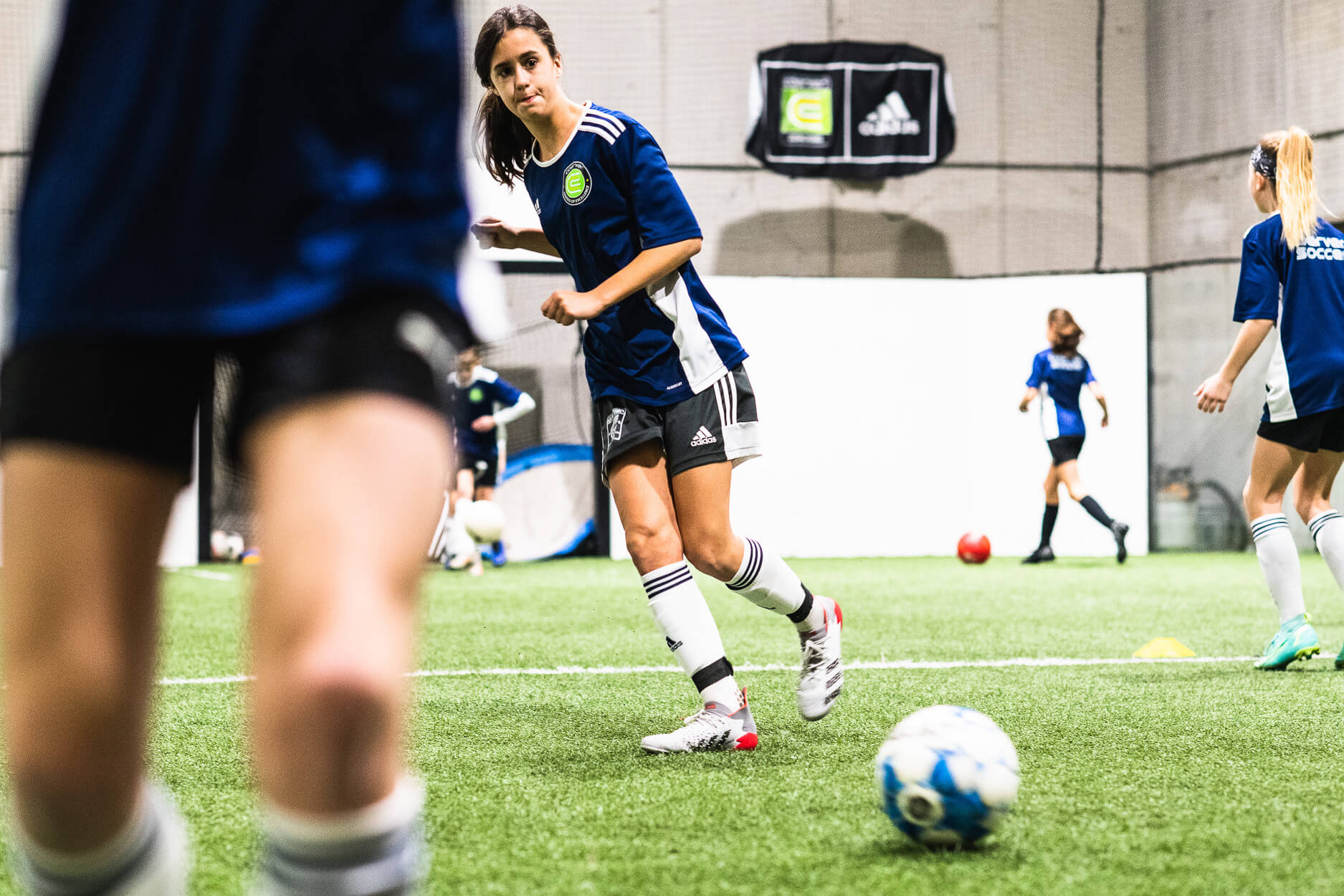“It’s about being comfortable on the Ball”
– Pia Sundhage, Former Coach, U.S. Women’s National Team, 2008 & 2012 Olympic Gold Medalists
The call came one day to a state youth soccer office. It was the coach of a state cup winner in the Under-14 age group. He complained that none of the players he was coaching had been selected for the state’s Olympic Development Team.
On and on he went about his team, until finally the person on the receiving end interrupted. “I’ve never seen your team play, but I can describe it for you. They are well organized on the field. They are always moving to get open. They pass brilliantly. They use the give and go, back passes, long passes to change the point of attack …” “Absolutely,” says the coach, who then resumes with how his team does this, his team does that, all the time emphasizing the passing and teamwork.
The coach of another team took those players to the state cup semi-finals at Under-12. Where they lost. When you watched that team play, the ball moved like this: win the ball (beating the first defender with the first touch), dribble and beat a second opponent, pass, pass, beat someone, beat another, pass, back pass, pass, beat another, shot.
Both teams won lots of games, most in fact, at their age level. One came up short as a team this time, but our bets were on them for the long term. The reason: the coach of one team had only a team. It was ‘built for today.’ The second team, though younger, had players – already well prepared for their tomorrows in The Game.
Just What Is a “Player”?
Successful soccer play requires more than knowing how to pass, move and work together. A player, in our definition, is first an individual with a dynamic first touch. She is poised and creative with a ball, confident in the ability to hold it under pressure and will, when needed, take on and beat an opponent in a one-on-one situation.
Facing a defender, a Player always has this choice: “I can beat you myself or I can beat you using a teammate.” He’s a double-edged sword, while his one-dimensional peer can only pass. In time defending against a team of one-way players becomes increasingly easy. Defending against a team of Players, however, will forever make you crazy.
“I Thought This Was A Team Sport.”
It is. And to those who grew up playing other team sports, an emphasis on individualism and creativity seems almost “un-American.” (Wasn’t “ball hog” among the worst names you and your friends used?) Please understand, we do not advocate kids playing 1 v 7 (or 9 or 11.) But we do want to develop players who could play “1 v Many” (and might be inclined to try!) yet who also recognize when a pass is the better choice. This, though, is critical: the player must have both the skills and confidence to allow that choice.
Why “Players First”?
“Skillful Players First, then team” is here a conscious choice. That choice can and should be made for several reasons:
Team play is essentially impossible without the ability to control the ball. (Just keep track of the high percentage of “one-touch” balls that are just given away to the opponents in the next youth game you watch.) Conversely, a team of skilled Players will match up well from their first full-field game together against an established team where skill development is not the primary focus.
Developmentally, children at the younger ages are more inclined toward individual than team play. Teamwork is more natural when athletes reach an age where the peer group becomes important.
Developing individual skills is tougher for older kids.
It can be done, but requires hours and hours of very basic practice and repetition that can try the patience of older athletes. Starting younger, such practice can be spread over a longer time.
In our experience, it is far easier to teach the dribbler to pass than to teach the passer to take someone on. It’s difficult to “retrofit” a 12 year old who has only experienced the passing side of The Game and whose other skills are underdeveloped. Even then, it is rare for an athlete to reach the level of technical or tactical proficiency in the 1v1 situation that he would have gained from strong and ongoing skills training beginning at age eight or nine.
Strong skills allow every player to be in control of the game. It has been said that in soccer every player is a quarterback. Any player who can control the ball and play with poise and confidence in 1v1 match-ups is truly in command when the ball is at her feet.
It works. Teams and clubs that have adopted this philosophy of player development (mandating, for example, that 75% of training through U14 be centered around skill development) have seen huge increases both in the number of players chosen for Olympic Development Teams and in team success in league and tournament play.
Individualism Enables Teamwork.
Individual creative play is the key to great teamwork in soccer. The player who takes on and beats an opponent now continues to goal with a numerical advantage. The next defender, suddenly outnumbered, immediately faces two options. Challenge the dribbler: the pass is open. Deny the pass: the dribbler continues to carry the ball forward.
It’s called “forcing the defender to make the wrong choice,” where either choice is wrong! Skillful, creative Players use “the individual option” to put defenders into positions where they must continually make those no-win choices.
Walking The Walk.
It’s easy to talk about the importance of individual player development. Too often, though, the commitment to that principle disappears under the ever-increasing pressures tied to wins and losses – now seen at younger and younger ages. The development of creative and skillful individual players can be at some initial cost to team “success”, especially if measured just by the scoreboard. It’s faster and easier to ‘win on the cheap’ by emphasizing team organization over the development of the players.
What we’ve learned, however, is that teams developed using the Players First philosophy quickly become surprisingly “successful”. Not too long ago, three of the five U9 winners in a state recreational tournament were teams trained with a primary focus on player development. None were the better “teams”, nor were they teams “stacked” with the best athletes. They won because player-for-player they had developed skills superior to those of their opponents. Such skills form a rock solid foundation for further development of creative, attractive and effective team play that will be successful by any definition. More importantly, those players already have the tools to allow them life-long enjoyment of The Game.
Be Patient. Be Persistent.
And be happy when your players show poise, show confidence, show creativity, show some flair with the ball. Create an environment of fearlessness – where attacking one-on-one is “always allowed, is usually encouraged, and is frequently demanded.” When your players dribble too much at first – as some will – suppress the “pass the ball” responses from your sidelines. Once they have the take-on mentality you can begin to develop their options involving teammates.
Like the second of those teams mentioned at the top, your teamwork may come up short at first. In time, your players will learn to recognize and make the better choices. Then the team becomes unstoppable.
The coach of that second team placed five athletes on her state’s youngest Olympic Development Team. She had developed Players ‘built for tomorrow’ with the abilities and characteristics that would allow them to go anywhere and play well for anyone. The team’s moment came two years later in a state cup final where skill and poise with the ball prevailed over size, strength and speed for the first of several state championships.
*an excerpt from “Players First” written by Coerver Coach Bill Dooley




